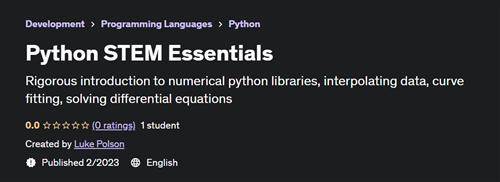
Published 2/2023
Created by Luke Polson
MP4 | Video: h264, 1280x720 | Audio: AAC, 44.1 KHz, 2 Ch
Genre: eLearning | Language: English | Duration: 8 Lectures ( 2h 29m ) | Size: 2.88 GB
Rigorous introduction to numerical python libraries, interpolating data, curve fitting, solving differential equations
What you'll learn
python libraries for scientific analysis
numerical integration, interpolation of data, curve fitting, differential equations
how to calibrate a photon detector used for medical imaging
how to solve biological equations governing populations of various species
Requirements
Basic Python Programming Experience (i.e. understand for loops, if statements, functions)
Basic Mathematical Knowledge (i.e. calculus, basic statistics)
Description
This course is an introduction to useful python functionality in scientific research and engineering applications that is rarely taught rigorously in universities. It begins with an overview of required numerical libraries, such as NumPy and SciPy, and eventually moves on to techniques such as interpolation, curve fitting, and solving systems of differential equations. A heavy emphasis is placed on real world examples; datasets will be examined in lectures, and students will expand on the analysis of these datasets in the 5 thorough course assignments. At the end of this course, you will feel comfortable using python as your preferred programming language in a research setting. In addition (and most importantly) you will have learned to properly interpret output, such as the error on parameters in curve fitting, and what an interpolated data point actually means.Some datasets examined include: radioactive particle energy measurements obtained in a crystal detector, photon spectrum in a radiotherapy unit used to treat cancer patients, and photon attenuation data in a block of lead. In the differential equation section, we will look at solving the following systems of equations: the pendulum, projectile motion with friction, the Lotka Volterra equations, and finally (a question that combines most concepts of the course) dark matter evolution throughout the history of the universe.
Who this course is for
Undergraduate students just getting into research
Graduate students that want to use python as their primary language for research
Engineers looking to use python to analyze data
Homepage
https://www.udemy.com/course/python-stem-essentials/Fikper
jdoxr.Python.STEM.Essentials.part3.rar.html
jdoxr.Python.STEM.Essentials.part2.rar.html
jdoxr.Python.STEM.Essentials.part1.rar.html
Rapidgator
jdoxr.Python.STEM.Essentials.part3.rar.html
jdoxr.Python.STEM.Essentials.part1.rar.html
jdoxr.Python.STEM.Essentials.part2.rar.html
Uploadgig
jdoxr.Python.STEM.Essentials.part2.rar
jdoxr.Python.STEM.Essentials.part1.rar
jdoxr.Python.STEM.Essentials.part3.rar
NitroFlare
jdoxr.Python.STEM.Essentials.part1.rar
jdoxr.Python.STEM.Essentials.part2.rar
jdoxr.Python.STEM.Essentials.part3.rar
Please Help Me Click Connect Icon Below Here and Share News to Social Network | Thanks you !
